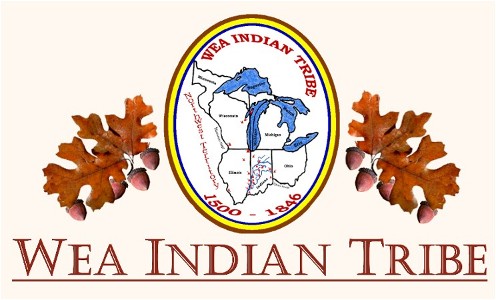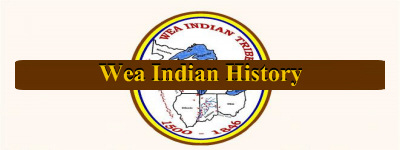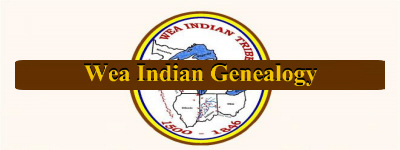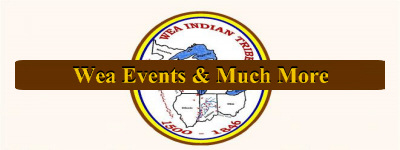




After many struggles with the powerful Iroquois over the land, the Wea moved for a short time to the Chicago area (prior to 1688). We then moved into upper Indiana, and eventually settled into the central west to southern west of the state (prior to 1700). The Wea dominated from around the Lafayette area all the way to Vincennes, and as far east as past Thorntown, Indiana until after the removal times. This area was known as part of the Wabash River Valley, also known as the Northwest Territory.
There were also groups of the Wea living, from time to time, in Ohio in and around Greenville and Darke County, and some of us were in Illinois around Kaskaskia & Fort de Chartres, and the Kankakee Portage. The majority, or main villages of the Wea were in Indiana after 1600. The Wea were one of the first inhabitants to live in, and make a permanent home in Indiana.
The Piankeshaw, Peticotias (Pepicokia), Eel River, Mangakekis, Kilataks, and Gros were all Wea sub-tribes or clans/bands within the same Nation. Today, except for the Piankeshaw and Eel River, they are either extinct/unknown or have been absorbed into other tribes. The Piankeshaw & Eel River in the 1800's were treated with separately from the Wea by the government and by doing so became their own Nations or Tribes. We are part of the great Algonquian Peoples, aka Woodland Peoples. The Wea Clans or Bands are: Serpent, Bear, Deer, and Acorn. Our colors are Cobalt Blue, Red, Yellow, and reddish Brown. We have been told that our Peoples name (Wea) means "the forest people" or "light skinned ones" or "people who live near the river eddy." We think that ALL three identify us well.
The removals began for our People in the early 1820's, but not much was done until the 1830's. Christmas Noel Winriscah Dagenette (b.1799-d.1848), had the grim task of leading the People west. He made three trips taking the People to their "new home." The forced removal came in 1836-1846, when our People were herded like cattle and placed upon steamboats up and down several rivers and transported across the Mississippi to Kansas. We were dumped there and had to walk on foot the rest of the several hundred miles to our "new home." The Government had promised to feed, water, and shelter us upon our arrival that first year........they never showed up. Of the 350 souls that made the trip, over 150 of us died from starvation, disease, and broken hearts. One of our Grandfathers said; "If it hadn't been for the rattlesnakes in our new home, we would of starved to death that year." Christmas Dagenette died in Kansas in 1848, after his last trip there. He is buried near Louisburg, Kansas. Today many of his descendants still live in Kansas, Oklahoma, and Missouri.
Not all the Wea went west, some stayed behind by fleeing into the wilderness of the deep forest of southern Indiana and Ohio. Wea Principal Chief Jacco Tackeketah Godfroy (b.1777-d.1854) was one of those, among other Wea families, that took his family and left. He saw what the White Government was doing, and before the removals came he went away. Some years afterwards, he came back to Indiana. In his last years, he lived with his daughter. He died there with her on her farm, and was buried in his beloved homeland of Indiana. Jacco is the 4th great grandfather of our present day Tribal Elders: Max Haffner and Ray Haffner, as well as many others. Today many of Chief Jacco's descendants still live in Indiana, Ohio, Illinois, and Michigan.
After a while in Kansas, the Wea, Peoria, Kaskaskia, and the Piankashaws, because of their small numbers joined forces. They asked, and were granted by the U.S. Government, to combine their tribes. They were then known as the Confederated Peoria Tribes. This was done in the Treaty of 1854. After 1854, in Indiana the Wea were considered extinct by the U.S. Government. Later the Confederated Peoria Tribes were reinstated as a federally recognized Tribe by the U.S. Government, and today are known as the Peoria Indian Tribe of Oklahoma. Many historians refer to the Wea as Miami, or a sub-tribe of the Miami. However, we were and always have been our own People and Nation.
Our Main Purpose
is to honor our Ancestors by bringing back our language, history, culture, spirituality, and religion; and instilling some of the customs of the Old Ways for our People, and our future generations. To locate all the "Places of our Ancestors" and get them cleaned up if need be, and to get them recognized as Wea Ground and marked as such.Our Main Goals are to be recognized, not necessarily by the U.S. Government, but by and from our fellow Native American Indian brothers and sisters. To belong! To share, teach, and experience our ways and history with all People, not just Native Americans. To teach our children and help others to understand us; to locate and reach out to all Wea no matter where in the world that they live; to let the world know that we are NOT extinct. We are ALIVE, PROUD, and THANKFUL to the Creator to be Wea People.
Who Are We? We are the descendants of the once great and powerful Wea Nation, or Tribe of Indians. We are part of the First People of America. In the past, descendants of the Wea People have been coming together for years celebrating their culture, and sharing and exchanging their history and family genealogy. Today our Tribe is still full of these same people with the same ideas for promoting our Peoples history, culture, religion, language and lifestyle. The group is now much larger and is growing with new members everyday. We not only reach out to our own People, but to ALL people no matter their race, creed or color of their skin. The Tribe is no longer a small family unit, while this still holds true; we are also now in the eyes of the public: through sharing, educating, donating physical labor, or whatever the need may be to those we help.
The Wea Indian Tribe of today started getting together as family in the early 1990's. By 1994, we were having family reunion picnics and sharing history, notes, genealogy and pictures of our past Ancestors. This "meeting of family" was the direct result of Max Haffner and Ed Melton's over 35 years of research into our past, and finding our living family members. There were others in the family that had done the same as Haffner and Melton. They were the Fuller, Sills, Boxell, Mendenhall and Upgrapht families that led us all together.
As time passed, we realized that the "family" wanted and needed more. Thus, some of the families started work on reforming the Tribe in 1997. On the other side of the United States, other Wea families were searching for missing family members too, unknown to the rest of us. We all found one another late in the year of 1999, and thus the Wea Family has grown. We have members across the U.S.A., and abroad in Australia, France and the UK. As of September 1999, we had our first Annual Wea Indian Tribal Gathering, and our second in August of 2000. Our Annual Gathering has been held every year since. Our governing body, the Tribal Council (aka the Board of Directors) has been formed, and bylaws are in place. The Tribe became Incorporated, Nonprofit and Tax Exempt in the year 2000. In the future, we might seek state recognization, if the State of Indiana ever develops criteria for such.
Past Activities: The descendants of the Wea People held yearly reunions between the years of 1994-1998. These reunions were held in a public park, and newspaper announcements and flyers were placed and passed out to advertise the event. The reunions were an all day event, usually hosted by one or more families. These families would furnish the pavilion or shelter house, supply food and drinks for all, and furnish napkins, plates, silverware, cups, and so forth. Activities of the reunions included talks on past Wea Tribal history, culture, religion, who graduated and who got married. There was much sharing of materials, knowledge and documents. The time involved in putting on these reunions would span out over a period of months. The reunions were held for all Wea descendants.
By June of 1999, our group had changed to be officially known again as the Wea Indian Tribe. We created a Roll List, and started the groundwork for the operation of the Tribe. Members were required to fill out a membership application and submit an application fee, which was then placed in the Tribal funds to help cover the cost of genealogy research for the members, mailings, stamps, envelopes, flyers, announcements, office supplies and all other related expenses.
In 1999, the Wea Tribe changed their structure for the annual reunions. We realized that the Wea descendants wanted and needed more, as well as some very interested people from outside the Tribal unit. We decided to have Wea Indian Tribal Gatherings, which would last for four (4) days. Our Gatherings would now include rich history and genealogy sessions, the teaching of our language, culture, religion, traditions, and the Old Ways per our Ancestors. They would include trips (sight-seeing tours) to the various places of our Ancestors, historical monuments, museums, etc. We held craft sessions that included the teachings of our People about traditional clothing, hunting gear, beadwork, weapons and other related subjects. This will continue on in the present and in the future.
In September of 1999, we hosted our first Wea Indian Tribal Gathering. It was held near the site of the old Wea village of Ketheippecanunk and the Battle of Tippecanoe. The event was open to all Wea descendants and any other interested persons. The Gathering also included several Guest Speakers, such as professors of history, history buffs, genealogists, specialists on powwow structure and etiquette, storytellers and more. Food, drinks, and the necessary supplies needed for the event to accommodate the people in attendance was planned and provided for. The grounds had to be rented for the event, and flyers and newspaper advertisements were placed. Members volunteered their time in demonstrating dancing and crafts, teaching the history, genealogy, herbs, spiritual matters, storytelling, meal preparation, babysitting, and general camp clean up. Tours and sight-seeing were taken to some of the historical sites, and members guided the interested persons to these places. The time involved in putting on the Gathering stretched into several months.
In November of 1999, the Wea Tribe was asked by Professor Mr. Ben Welsh of Ball State University College to come and do a presentation about the Wea Indians for his Multicultural Class. Preparation for this speech took about four (4) weeks to prepare the needed materials involved. The lecture was held on November 12, 1999 and lasted the entire length of Mr. Welsh's two-hour class session. We spoke on the Wea history, lifestyles, our hardships, and personal feelings; all challenging the class to recognize the Native American Indian People of today. We spoke about Fort Ouiatenon and the Wabash River Valley, the Removal Times, War and Disease, discrimination, schooling and education, customs, beliefs, ceremonies, powwows, and Indian life of present day time. The lecture was closed with flute music, and a question and answer session with the students.
Shortly after this, the Wea Tribe started a newsletter for the People, about the People, Tribal events, happenings and goals, titled "The Wea Primer". We have since had ten (10) editions go out. A website was built, and a Tribal email account was set up. All involved countless hours and time, but minimal expense. The Tribal Council Members share these duties. The newsletter is ongoing, and at this time will continue annually.
In May of 2000, the Wea Tribal People were invited to the Miami Nation of Indians of Indiana's Annual Language Camp. Many from our organization attended. The main function at the camp was the teaching and learning of our ancestral language. Educating the people on their language is very valuable in keeping the Indian Peoples culture and customs alive and preserved. When a language is lost, so goes with it some of that races culture and heritage. Available for purchase were the Miami Language Materials, which is the same dialect of the Wea Indians. At that time, each individual who wanted the language materials bought it themselves. In the future, the Tribe would like to be able to purchase additional sets of the Language Materials to help those families, who can not financially afford their own. We hope that in the future, we will be able to provide some kind of classroom atmosphere for helping others to learn our language.
In August 2000, we had our Second Annual Wea Indian Tribal Gathering. It was put on in the same fashion as the one in September 1999. It was held on the same grounds and all the same preparations were done. The only difference this time was that we had quite a few more guests to join us. Professor Ben Welsh from Ball State University spoke on different cultural spiritualities and told of prophecies from these cultures. A man from Purdue University of Science and History Engineering, and a Lakota descendant gave a lecture. The Red Hawk People from Ohio attended and shared their expertise and knowledge with us on the spiritual issues of Native American Indian Peoples. This year, we also set out a "donation can" for anyone who cared to donate towards the Tribe's causes and events.
September 17, 2000 was the date that the Wea Indian Tribe adopted our Bylaws. The Bylaws were worked on for at least six months by all Council Members. They were researched, drafted, inspected by all, and finally approved and voted on by the Tribal Council (aka the Board of Directors). Throughout the whole year of 2000, we have continued to attend different Native American functions, participate in others' powwows, gatherings, lectures, events, and activities as already described above. All of these things will be ongoing activities of the Tribe in the future.
In the past, the Wea have been active with the American Indian Council of Lebanon, Indiana; held a scholarship powwow to raise money for the Wea college students; and individuals supported and helped to get the Native American Indian Affairs Commission of Indiana established.
What Do We Do? Individual persons within our Tribe have spoken with historical societies, libraries, professors, other Tribal Leaders, genealogists, Feast of the Hunter's Moon staff and coordinators, and other professional people promoting the knowledge of our People and Tribe, as well as gathering information about our past. Individual persons, or small groups of members, have always attended other Native American Indian events such as: powwows, gatherings, feasts, long house ceremonies, drum practice, teaching fires, lectures, studies and presentations.
Today the Wea are active participants with the Native American Foundation of Western Indiana, helping with their yearly "Gathering of the Peoples Powwow" by giving historical lessons to the school children on Children's Day, held on Fridays before the powwow and hosting our Tribal booth during the powwow. And we also work in conjunction with the Foundation to place Native American Historical Markers throughout Indiana. We work with the Tippecanoe County Historical Association (TCHA) where we are involved in presenting a Native American Indian Living Village on our homeland of Ouiatenon, several times throughout the year and at the annual Feast of the Hunter's Moon. We help SENAA International with different issues; they are a Native American Alliance organization, who function throughout the U.S.A. and abroad. Their site is: www.senaa.org
For information on Copyright & Infringement Laws See:
Website & Photo ©Copyright Laws
(in above menu selection)

